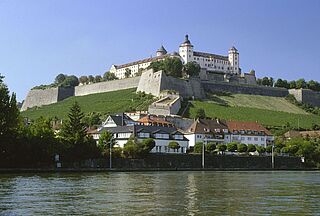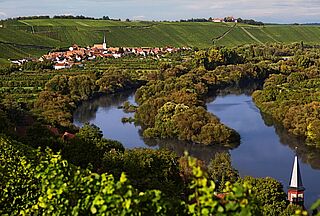Homburger Kallmuth
Kendte vinmarker
Homburger Kallmuth
Steep, Terraced Amphitheater of Vines on the Main River
Home to Rare Flora and Fauna. From a look at a map, the Main River seems to form a large W as it loops its way through the heart of the Franken wine-growing region. Thats a convenient way to remember that the regions wine and cultural capital is the beautiful city of Würzburg.
The village of Homburg is about 26 km/16 miles west of Würzburg and some 16 km/10 miles east of Wertheim (“little Heidelberg”), where the Tauber River flows into the Main.
The region’s soils, from west to east, are as follows:
- near and northwest of Aschaffenburg (45 km/28 miles east of Frankfurt am Main) primitive rock and mica schist prevail
- south and east of Aschaffenburg warm, red sandstone prevails
- near Wertheim/Homburg there is a transition: lower stratum of red sandstone with an upper crust of shell-limestone; further east, including Würzburg and Volkach, shell-limesone predominates
- easternmost portion of the region (bordering the Steigerwald/Steiger Forest), gypsum keuper/red marl prevail.
The latter three soil types (red sandstone, shell-limestone, keuper) were formed ca. 225 million years ago in the Triasic Period. They account for some 90% of the region’s soil composition.
Homburg lies on a bend of the Main River. As such, the Kallmuth site is a concave slope, or amphitheater, of vines soaring uphill from the riverbank at a gradient of up to 75–80 percent, at an altitude between 146–212 meters/479–696 feet. It is quite a dry site – so in warm years with little rainfall, the vines can suffer. The vineyard faces west–southwest, a favorable exposition for collecting sunshine during the day, supplemented by its proximity to the river, which reflects the sun’s rays onto the hill.
Last but not least, the microclimate is favorably influenced by the 12 km/7.5 miles of dry stone walls that terrace the entire site. They, too, collect and reflect heat. Even in the coolest summers temperatures can easily reach 50–60°C/122–140°F, thereby creating a sub-Mediterranean climate. These walls, ranging in height from two to five meters (6.5–16.5 feet), are inherent to this cultural landscape and were placed under historical preservation status in 1981. They are extremely expensive to maintain/repair.
The site today consists of ca. 12 ha/30 acres of vines, of which ca. 8 ha/20 acres are productive. It is planted primarily with Silvaner and Riesling grapes, supplemented by small quantities of the rarity Rieslaner (Silvaner x Riesling crossing). Many of the vines are over 40 years old. The wines have an earthiness and mineral tone as well as spicy, herbal aromas combined with those of ripe fruit. Some writers say the Kallmuth wines pose a challenge for novices. Nevertheless, they are appreciated by connoisseurs as wines with great complexity, depth and aging potential. A massive renovation program of the terrace walls/replanting of vines is in the works. In spring 2006, work on the dry stone walls was completed. The next step will be replanting an additional 1.5–2 ha (just under an acre), primarily with Riesling and Silvaner. A very small portion of Sauvignon Blanc will also be planted.
Origins and Owners
The name Kallmuth derives from the Celtic “calemont” – “kahler Berg” or “barren hill.” It is assumed that it was first planted with vines by Benedictine monks in the 9th century. The first documented mention of vines on the “Kalemunt” hillside, however, dates from 1102, in a deed of gift from the monastery Kloster Neustadt to the (then) newly founded abbey in Triefenstein.
Today the site is solely owned by Weingut Fürst Löwenstein. The estate first purchased parcels in the site in 1803, in the aftermath of secularization (post-Napoleonic era); additional parcels were acquired at auction in 1872, for 22,000 Gold Marks – in exchange for its holdings in the Würzburger Stein site.
Given the Kallmuth’s favorable microclimate, it is a haven for rare flora and fauna. The “sky blue butterfly” and the grass lily Asphodill, rarely seen north of the Alps, are at home here, as is the vetch plant Coronilla. Both plant names are used to denote particularly fine wines of the Löwenstein estate.
Weingut Fürst Löwenstein is a member of the VDP (Association of German Prädikat Wine Estates) and supports the organization’s private-law vineyard classification. The Kallmuth site is classified as a very top site suitable for producing wines of “Grand Cru” quality. It comes as no surprise, then, that British wine writer Hugh Johnson refers to the Kallmuth site as “one of Germany’s most spectacular slopes.”
Tips for Tourists
The three cities mentioned above – Würzburg, Wertheim and Aschaffenburg – all have sights and museums worth visiting. The magnificent Residence in Würzburg is a UNESCO World Heritage site, and the city has many fine Gothic and baroque structures to admire inside and out. The massive Marienberg fortress overlooks the city and houses the Mainfränkisches Museum with a wine museum, Franconian folk art and works by the Gothic sculptor Til Riemenschneider. Last but not least: three of Germany’s large, traditional wine estates are situated in Würzburg: Staatlicher Hofkeller, Bürgerspital zum Heiligen Geist and Juliusspital. Each has beautiful cellars (visits by appointment) and each has a wine restaurant that serves their wines with local cuisine.
The imposing ruins of Wertheim castle that overlook the city gave rise to the nickname “little Heidelberg.” The Old Town abounds with historical facades. There is a remarkable collection of costumes (1800–1950) in the history museum, and not only wine lovers will enjoy the fascinating exhibits in the glass museum that chronicle the history of glass making from Egyptian times to the present.
Wertheim is the gateway to the Tauber River Valley, a peaceful and picturesque landscape dotted with vineyards and orchards. The wines of three regions can be found along the Tauber: Franken, Baden and Württemberg. After a series of loops just south of Wertheim, the Tauber flows upstream to Bad Mergentheim (once the residence of the Teutonic Knights, today a spa), then turns eastward, taking in the towns of Weikersheim (Princes of Hohenlohe’s Renaissance hunting palace with fabulously furnished period rooms) and Creglingen (famous Riemenschneider altar in the Herrgottskirche) before reaching the medieval walled town of Rothenburg ob der Tauber.
Aschaffenburg was once the second home of the prince electors and archbishops of Mainz. The Renaissance sandstone palace Schloss Johannisburg houses an art museum (17th-century Dutch masters), the city museum, and period rooms. The interior of the Stiftskirche (collegiate church) and its Romanesque cloisters are also impressive. From Aschaffenburg it is but a short drive to Klingenberg, Miltenberg and Bürgstadt. Many of the vineyards here are planted with Spätburgunder (Pinot Noir) and some of Franken’s finest red wines originate from this part of the region.


